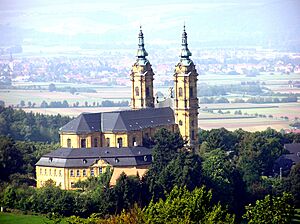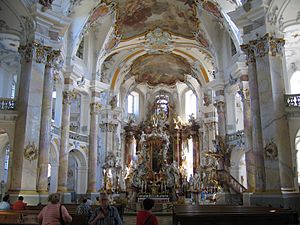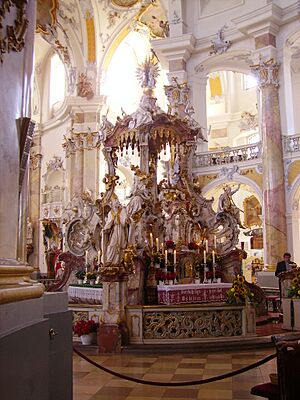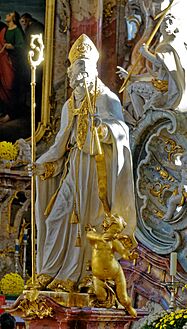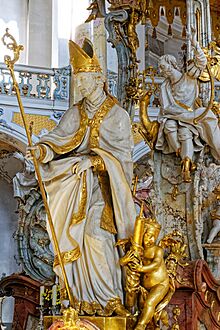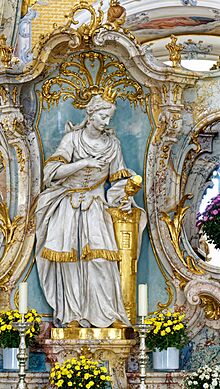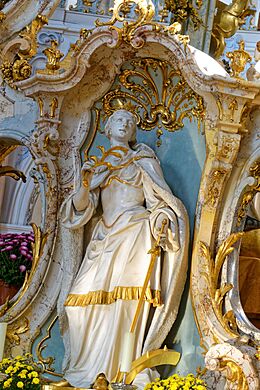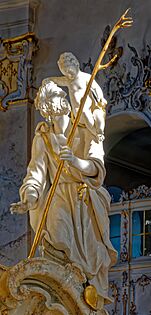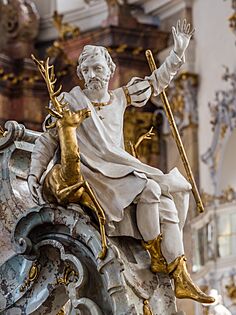Basilica of the Fourteen Holy Helpers facts for kids
Quick facts for kids Basilica of the Fourteen Saints |
|
|---|---|
|
Basilika Vierzehnheiligen
|
|
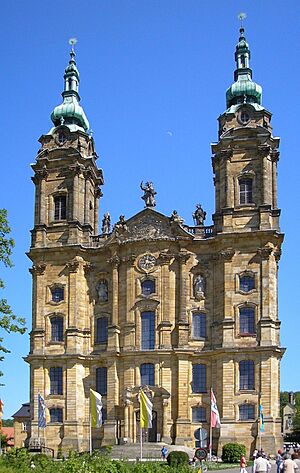
The Basilica of the Fourteen Saints
|
|
| Lua error in Module:Location_map at line 420: attempt to index field 'wikibase' (a nil value). | |
| Location | Bad Staffelstein |
| Country | Germany |
| Denomination | Roman Catholic |
| History | |
| Dedication | Fourteen Holy Helpers |
| Architecture | |
| Architect(s) | Balthasar Neumann |
| Style | late Baroque-Rococo |
| Years built | 1743-72 |
The Basilica of the Fourteen Holy Helpers (which in German is called Basilika Vierzehnheiligen) is a beautiful church in southern Germany. It is located near the town of Bad Staffelstein in Bavaria. This amazing church was designed by a famous architect named Balthasar Neumann. It was built a long time ago, between 1743 and 1772.
The church is special because it is dedicated to the Fourteen Holy Helpers. These are a group of saints who were honored together in the Catholic Church. Many people, especially in Germany, prayed to them during difficult times, like when the Black Death was around. The inside of the Basilica is so fancy and beautiful that some people call it "God's Ballroom"!
Contents
Where is the Basilica?
The Basilica sits on a hillside and looks out over the Main River in a region called Franconia. On the hill across the river, you can see Schloss Banz, which used to be a large monastery. These two important buildings together are known as the Goldene Pforte, or "golden portal." It's like a grand entrance to historic towns nearby, such as Coburg, Kronach, Kulmbach, and Bayreuth.
The Legend of the Fourteen Helpers
The story of the Basilica began on September 24, 1445. A young shepherd named Hermann Leicht was in a field near a Cistercian monastery. He saw a child crying. When he tried to pick up the child, it suddenly disappeared! A little while later, the child appeared again in the same spot, this time with two glowing candles floating nearby. Hermann told the monks about what he saw.
The next summer, Hermann saw the child a third time. This time, the child had a red cross on its chest. Fourteen other figures were with the child. The child told Hermann that they were the "fourteen helpers." They would help people if a chapel was built for them. The two candles then floated down, and the vision vanished. After this, amazing healing miracles started to happen.
Just 18 days after the third vision, a very sick maid from Langheim got well. She had asked the Fourteen Holy Helpers for help. The Langheim monastery, which had not believed the stories at first, then understood that something special was happening. Soon, people began to make special trips, called pilgrimages, to this holy spot.
The Cistercian monks, who owned the land, built a small chapel. Many pilgrims came right away. An altar was set up there as early as 1448. People still make pilgrimages to Vierzehnheiligen today, usually between May and October.
How the Church Was Built
The church you see today was built from 1743 to 1772. Its unique and beautiful inside, in the Rococo style, came about because of a problem during construction. The Langheim Abbey wanted to save money. So, they changed the building plans even after the first stone was laid.
When Balthasar Neumann, the architect, found out, the walls of the three curved sections (apses) were already built. This meant the special Altar of Grace, which was where the visions happened and could not be moved, would not be in the center of the church as planned. Instead, it would be off to the side.
To fix this, Neumann cleverly divided the main space into three oval shapes. He made the Altar of Grace the center of the largest oval in the middle. He surrounded it with four columns on each side. This made the altar the true heart of the church again.
The Mercy Altar
The Mercy Altar, also called the Gnadenaltar, is the exact spot where the vision of the Fourteen Holy Helpers appeared. There are fourteen statues on this altar. They represent the saints:
- On the railing (balustrade):
* Blaise (February 3): A bishop who helps with throat illnesses. * Cyriacus (August 8): A deacon who helps against temptation when someone is dying. * Denis (October 9): A bishop who helps with headaches. * Erasmus (June 2): A bishop who helps with stomach problems.
-
St Blaise with a mitre (hat) and crozier (staff), holding crossed candles
- In the altar's special spots (niches):
* Barbara (December 4): A virgin who helps against fever and sudden death. * Catherine of Alexandria (November 25): A virgin who helps against sudden death.
- On the supporting structures (buttresses):
* Agathius (May 8): A martyr who helps with headaches. * Christopher (July 25): A martyr who helps against the bubonic plague. * Eustachius (September 20): A martyr who helps with family disagreements. * Giles (September 1): A hermit who helps against plague and for a good confession.
-
St Agathius in centurion armor holding a cross
-
St Christopher carrying a stick and the Christ Child
- On top of the canopy (baldachin):
* George (April 23): A soldier who helps with the health of farm animals. * Margaret of Antioch (July 20): A virgin who helps during childbirth. * Pantaleon (July 27): A bishop who helps physicians. * Vitus (June 15): A martyr who helps against epilepsy.
-
St George dressed in crusader plate armour and holding a lance
The Main Altar
The main altar, called the High Altar, is very tall and easy to see. It has a large painting that shows the Assumption of the Blessed Virgin Mary. This is a belief that Mary was taken up into heaven. Statues of her husband Joseph, her father Joachim, and important figures like David and Zachariah are also there.
The Pulpit
The pulpit is where sermons are given. It looks like it's floating! White angel-like figures called putti hold it up. The pulpit is decorated with golden pictures of the Evangelists, who wrote parts of the Bible. These pictures are surrounded by fancy shell-like designs. The top part of the pulpit, which helps the sound carry, is shaped like a sphere with rays coming out.
Images for kids
-
Nave of the Basilica
-
Crucifix on the High Altar
-
Altar of St Anthony


